Reaction to ‘It Happened’
Re: “Pomona College Museum Curator Rebecca McGrew ’85 and the Making of It Happened at Pomona”: I was a student at Pomona from 1964 –68 and lived in the area throughout the ’70s. While I know nothing of the inner workings and politics of the Art Department in those years, I never had the sense that the College was ever artistically conservative, especially in terms of collaborative artistic efforts and multi-media events.
I remember quite vividly various campus performance art pieces, “happenings,” midnight concerts and a heady artistic extravaganza in a deserted winery in Cucamonga. Art, dance, film, theatre and musical entertainment combined frequently and pushed cultural limits routinely.
I’ll never forget performing in a piece by the philosopher/composer Pauline Oliveros: loud electronic music filled the air inside and outside Little Bridges, Ms. Oliveros worked furiously in the balcony projecting ever-changing colored lights throughout the hall, and I had to improvise on my bassoon while a film of a walking rhinoceros’ armpit (leg pit?) was projected on me.
I remember, too, when Tim Paradise ’69 (subsequently the clarinetist of the St. Paul Chamber Orchestra) and I, amongst others, sat around an electric popcorn popper and waited for the popping corn to become our musical notes: We wore glasses with staff lines drawn on them.
Vulgarity was not confined to urinary art, which now strikes me as nothing that would shock anyone who ever went to a keg in The Wash. I remember conducting in Little Bridges at a well-attended midnight concert a trumpet concerto for solo trumpet and men’s chorus called Hum Job.
As far as I experienced, the College encouraged experimentation in the arts. If there was any lashing going on, it wasn’t conservative back lashing. In the current world of tabloid historians, rapacious bankers and cult politicians, a little experimentation might be in order again.
—David Noon ’68
New York, N.Y.
I read with great interest Suzanne Muchnic’s excellent article about the Museum of Art and the “It Happened at Pomona” exhibitions. As one familiar with the museum and its history, I have a good sense of the challenges involved in this hugely ambitious undertaking and applaud the staff, which is richly deserving of the accolades flowing their way. I also know how difficult it must have been to reconstruct a period for which only sparse records exist, and how important it is that this has now been accomplished.
The innovative art of the period in question, recollected now in relative tranquility, was understandably unsettling to the status quo—such is the nature of the cutting edge. Developing as it did during a period of widespread unrest on college campuses nationwide, it would have represented an additional challenge to already beleaguered administrators. One can only imagine the conversations the activities of the Art Department and gallery must have occasioned with conservative members of the campus community, and we can be sure that President Alexander’s skills at smoothing ruffled feathers were much in demand.
I didn’t move to Claremont until 1981, some years after the events in question, but, having worked with David Alexander for nearly 30 years, I would suggest a different, somewhat more nuanced interpretation of his response to the art scene at Pomona in the late ’60s and early ’70s. When Alexander interviewed me for the directorship, he told me about the gallery’s history and mentioned, in particular, Wolfgang Stoerchle’s performance and Michael Asher’s installation.
About the former, which incensed many and, at the very least, surprised others, he said only that it “raised some eyebrows,” a classic understatement typical of him. Of the Asher, he painted so gloriously detailed a picture that I still remember the mental image I formed. He had clearly been captivated.
Working with David Alexander throughout the last decade of his administration and, subsequently, on the College’s archives project, I gained great respect for his intellectual sophistication; his reluctance to dismiss any serious academic endeavor, however controversial; and his capacity to adjudicate the demands of conflicting constituencies. The last was, no doubt, a particularly onerous responsibility during the period chronicled by the museum’s exhibitions—a challenge quite possibly as daunting as those facing the artists whose work at Pomona helped shift the way we define and understand works of art.
—Marjorie L. Harth
Emerita Professor and Director,
Pomona College Museum of Art
As someone who was there, I can’t resist offering my own thoughts on the contention that “David Alexander was fed up with the Art Department because the artists were pushing boundaries and taking advantage. It was difficult for Pomona, fundamentally a traditional place, to really embrace that.’”
David Alexander was a most astute, perceptive and fair-minded person. However talented and inventive the student-faculty in the studio arts at Pomona may have been during those critical years, there were at the same time several unfortunate changes and departures in the art history faculty that helped make the department as a whole unbalanced and somewhat anarchic. We may be sure that the decisions and actions he took in the years after his arrival were in an effort to improve the stability and balance of the Art Department as a whole and to make it more responsive to the needs of its students.
As for the notion that Pomona was “traditional” and perhaps even conservative in its approach to the arts, I draw on my experience teaching in the Music Department from 1950 to 1994.
It is true we offered our students, both pre-professional and amateur, a rigorous traditional program of studies in music theory, history and performance (i.e., “applied music”). But our students had ample opportunity to hear and to take part in what was new music, truly contemporary, “avant-garde,” fresh and vibrant. For several decades, beginning in the ’50s, Professors Russell, Briggs and Loucks regularly took students to concerts of “new” (and “old”) music at the Monday Evening Concerts in Los Angeles (an internationally renowned series), as well as to events at USC and UCLA.
In retrospect, the offerings of concerts and lectures by both our own faculty and by many distinguished guests seem quite remarkable, bringing to the campus and to Bridges Hall luminaries that included Pierre Boulez, Karlheinz Stockhausen, John Cage ’32, Luciano Berio, Severino Gazzeloni, Mauricio Kagel, Cornelius Cardew …
We also attended, with some of our interested and devoted students, music-theater-performanceart events that were indeed “pushing boundaries and (perhaps) taking advantage.” One such, at UCLA, I recall, involved the Rachmaninoff Prelude in C sharp minor played with great concentration by a young man totally oblivious to the six naked young women who rode their bicycles around the stage, circling him and the piano! I believe firmly that many of our alumni (including my former students, some of whom are now in their 80s like me) will verify what I have said here, in my attempt to help clarify and to present an additional perspective on “what happened at Pomona.”
—Karl Kohn
Professor of Music and Composer in Residence, Emeritus
If only we had known! The raves say it all: “artistic feats … avant-garde action … creative energy … mythic status … flash of radical brilliance.”
Tossing lighted matches at a nude woman; getting naked and urinating in public; nothing short of pure genius.
When my cohort of surfers and beach bums did these things in the 1950s and 1960s, we were nothing but childish, antisocial, exhibitionistic idiots. If only we’d thought of calling it art— we, too, could have made history and joined the pantheon of Great Artists.
—Dave Rearwin ’62
La Jolla, Calif.
A Tragic Loss
As reported briefly in the fall issue of PCM David A. Waring ’03 died on Sept. 28, 2010. Twenty-nine years old, he had suffered for many years from an illness that continues to confound.Having been in touch with the Waring family, and having come to understand better both the challenges his life involved and the impact he had on friends and family, I offer here a bit more about David’s life.
Classmates, friends and family held a memorial service in Claremont in May. According to Matt Leavitt ’03, a roommate and friend, “He was absolutely intrigued by how people behaved, why we did what we did, why we were who we were. … Dave’s musical talent and ability were otherworldly. I used to tell him that while I played guitar, he was a guitarist. … Perhaps one of the most tragic aspects of Dave’s affliction was we’ll never know what he could have accomplished with the world of music. … It is in his thoughtful interpretations of art, music and life that Dave truly flourished both intellectually and spiritually.”
Dave’s mother, Pat Waring, said that “in his freshman year, Dave was ‘beside-himself-excited’ to find a seminar on mathematics and music. Professor Ami Radunskaya nurtured his love of ideas in music, and for her he wrote a paper on ‘the relationship of set theory and improvisation in jazz.’” She also spoke of his love of sports, with baseball his favorite. At Pomona, he was a DJ at KSPC, a calculus grader, a psychology experiment designer and an assistant in a Claremont arts program for the disabled.
After graduating from Pomona and while in Osaka, where he was teaching English, he was stricken with myalgic encephalomyelitis/chronic fatigue syndrome (ME/CFS). Pat Waring noted, “Dave valiantly battled ME/CFS, a disease one expert pronounced ‘monstrous’ and ‘subtle’ in the same breadth. … In the end, he remembered others who suffered from ME/CFS. He requested that his organs be donated to medical science to be used for research to solve the biological questions swirling around his disease. But because of the decades-long medical politics—the titanic battle between those who view ME/CFS as a biological disease and those who see it as a psychiatric one—his contribution is yet to be determined.”
Pat Waring is educating the public about ME/CFS, the diagnosis of which is currently undergoing reevaluation, and inspiring students to pursue research into this tragic and perplexing illness.
—Don Pattison
Past PCM editor
Bedbug Background
I read with interest the “Bedbugs are Back!” article by Sara Faye Lieber ’03, learning that Stanford Chemistry Professor Emeritus Carl Djerassi founded a company that makes a chemical which battles these pests by sterilizing them. One coincidental bit of information not included in this article is that Dr. Djerassi’s now deceased daughter, Pamela, was a member of the Pomona class of 1971.
—Steve Lansdowne ’71
Austin, Texas
Out of the Box
I always enjoy the magazine. In reference to the photo spread in the fall “Time Travel” issue depicting the Pomona College Wedgwood China, I bought my Pomona plates in 1948. I got them out of their box once for a luncheon in 2003.
—Connie Fabula ’48
La Jolla, Calif.
Tragedy at Sea
Regarding “The Pirate Trials” in the fall issue, Jean Hawkins Adam ’66 was a dear friend, even when we only got together occasionally. She lived life to the fullest, and shared her enthusiasm with those around her. Her e-mails and website made me feel as if I was adventuring with her and Scott on their trips around the globe. They are sorely missed. I can only hope this tragedy will awaken more people to the serious problem of piracy and the need to address it. Nations must take the pirate attacks very seriously and work together to stop them.
—Diana Grover Barris ’66
Long Beach, Calif.
Remembering
Motts Thomas
As the proud 40-year wife of a Pomona graduate, I am deeply grateful not only for the outstanding education Steve (Class of 1970) received at Pomona, but also for the continuing pleasure of reading your magazine. Thank you for the particularly thoughtful, poignant and provocative collection of articles in the summer 2011 issue. Like Dr. Elizabeth McPherson ’71 (“Born Still”), Steve’s future career in genetics research and teaching was set by his undergraduate work with Professor Larry Cohen.
As a proud graduate and trustee emerita of another outstanding liberal arts college, mine located “back east” in Wisconsin, I am also deeply saddened to learn of Dean Motts Thomas’ passing. During his short time at my college, Motts engaged in the same kind of relationship building and commitment to diversity thatled your Professor Swartz to rememberMotts’ time at Pomona with such affection.
But … last time I checked, my college was careful not to refer to your college as Cal Poly in Pomona. Perhaps next time you refer to my college, you could get its name straight as well.
—Priscilla Peterson Weaver
Class of 1969, Lawrence University
[Editor’s note: Our apologies for the mix-up with St. Lawrence University in Canton, N.Y. ]
Repartee and Regret
When I read the letters in the last issue, I realized that I, too, knew Leslie Farmer ’72 (“The Bequest,” summer 2011), and my memories also capture a distinctive person who walked a path of her own. I have two memories of her. First, Leslie wrote epigrams—short pithy sayings with deep implications. At that point in my life I thought all the epigrams had been written, and it was a complete surprise to realize someone could actually create these things.
The second memory concerns an exchange we had in the Sagehen. Leslie had written something critical of a situation on campus. I cannot recall what it was, but her piece was passionate in an academic way—allusions to literature or references to history or such. I thought she was being overly dramatic and silly, and I wrote a poem in rebuttal. The poem was set as if written by Leslie. It began “Why, oh why, is the ivy dead on the halls of old PC?” From there I threw in a number of disconnected worrisome queries drawn from my still limited liberal arts education. I closed with the vengeful retort, “Stupid Leslie, it’s winter.” (Forty years before “It’s the economy, stupid.”)
I was very proud of myself, and I assumed there was no possible retort to my sharp pen. However, I was wrong. Leslie took up the challenge and responded with a longer, more complex and probably more informed response. Perhaps she was enjoying the engagement, but I knew I lacked the substance to continue the exchange, and I left the field of battle.
If I’d had the wherewithal to respond, I might have come to know her better. Even all these years later my encounter with Leslie stands out as a very formative event for me.
—Brian Stecher ’68
Santa Monica, Calif.

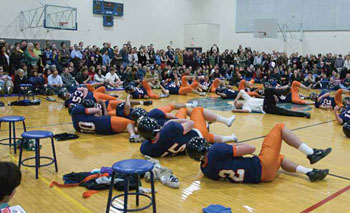 The evening began with White’s Preparation F in Memorial Gymnasium. The audience gathered around the center floor as Pomona-Pitzer football players, in street clothes, streamed in to the gym and grabbed chairs from an artfully arranged pile.
The evening began with White’s Preparation F in Memorial Gymnasium. The audience gathered around the center floor as Pomona-Pitzer football players, in street clothes, streamed in to the gym and grabbed chairs from an artfully arranged pile. Closing the program, James Turrell recreated his 1971 performance Burning Bridges, a visual spectacle which used road flares to give Big Bridges the appearance of being lit on fire. (The original unannounced performance led a startled witness to call the fire department.) This time, with everyone (including the fire department) in on the joke, there was a crowd watching from Marston Quad as the flares, hidden behind Big Bridges’ columns, enveloped the building’s arcade in a brilliant orange glow and silence gave way to the rising sirens of approaching fire engines.
Closing the program, James Turrell recreated his 1971 performance Burning Bridges, a visual spectacle which used road flares to give Big Bridges the appearance of being lit on fire. (The original unannounced performance led a startled witness to call the fire department.) This time, with everyone (including the fire department) in on the joke, there was a crowd watching from Marston Quad as the flares, hidden behind Big Bridges’ columns, enveloped the building’s arcade in a brilliant orange glow and silence gave way to the rising sirens of approaching fire engines.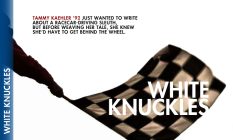
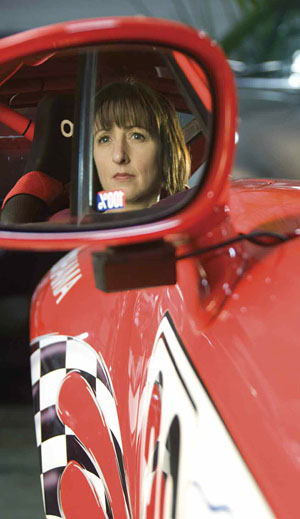 I hadn’t wanted to go to racing school. I’d rather not go fast, and I’m not the physically adventurous type. The only boundaries I like to push are how many books I can read in a week. But I’d had the idea to write a mystery series set in the car racing world after working in corporate marketing for a racing series sponsor. The fact that I’d never written a mystery—that I’d written fiction for the first time in my life only a few months prior—hadn’t stopped me from pitching my nascent idea to a published author. She encouraged me, with one caveat: My sleuth, who I’d seen as a woman in corporate marketing, had to be the racecar driver.
I hadn’t wanted to go to racing school. I’d rather not go fast, and I’m not the physically adventurous type. The only boundaries I like to push are how many books I can read in a week. But I’d had the idea to write a mystery series set in the car racing world after working in corporate marketing for a racing series sponsor. The fact that I’d never written a mystery—that I’d written fiction for the first time in my life only a few months prior—hadn’t stopped me from pitching my nascent idea to a published author. She encouraged me, with one caveat: My sleuth, who I’d seen as a woman in corporate marketing, had to be the racecar driver. Sooner than I wanted it to, the moment of truth arrived: my first solo laps. I sat waiting in the rumbling car, sweating and terrified, hoping my shaking legs would be able to work the clutch and throttle. I wondered again why I was doing this and why I hadn’t chosen something more normal and less violent to write about besides racing. Tea parties and embroidery, perhaps. And then they waved me out.
Sooner than I wanted it to, the moment of truth arrived: my first solo laps. I sat waiting in the rumbling car, sweating and terrified, hoping my shaking legs would be able to work the clutch and throttle. I wondered again why I was doing this and why I hadn’t chosen something more normal and less violent to write about besides racing. Tea parties and embroidery, perhaps. And then they waved me out. Since she was working for the company putting up the cash, Kaehler got inside access at the track, riding in top-of-the-line Porsches and meeting “everyone and their uncle.” She became fascinated with auto racing: the money, the violence, the rock-star drivers.
Since she was working for the company putting up the cash, Kaehler got inside access at the track, riding in top-of-the-line Porsches and meeting “everyone and their uncle.” She became fascinated with auto racing: the money, the violence, the rock-star drivers.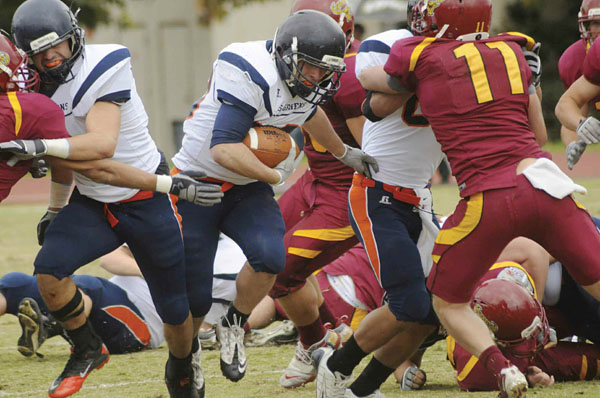 Running back Luke Sweeney ’13 led all of NCAA Division III football in rushing this season, averaging 177.4 yards per game for Pomona-Pitzer and setting both single-game and single-season school records along the way. Featured in the Los Angeles Times and USA Today for his standout season, Sweeney’s path to Sagehen sports stardom began half a continent away in the suburbs of Tulsa.
Running back Luke Sweeney ’13 led all of NCAA Division III football in rushing this season, averaging 177.4 yards per game for Pomona-Pitzer and setting both single-game and single-season school records along the way. Featured in the Los Angeles Times and USA Today for his standout season, Sweeney’s path to Sagehen sports stardom began half a continent away in the suburbs of Tulsa. “Nowhere in the public discourse did we see a reflection of the funny, independent and opinionated Muslim women we knew,” says Maznavi, who, with co-editor Ayesha Mattu, thought an anthology could help fill the void. “We decided to compile our faith community’s love stories as a celebration of our identity and heritage, and a way of amplifying our diverse voices, practice and perspectives.”
“Nowhere in the public discourse did we see a reflection of the funny, independent and opinionated Muslim women we knew,” says Maznavi, who, with co-editor Ayesha Mattu, thought an anthology could help fill the void. “We decided to compile our faith community’s love stories as a celebration of our identity and heritage, and a way of amplifying our diverse voices, practice and perspectives.”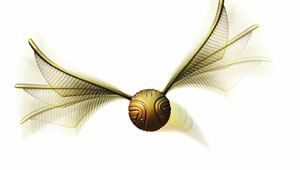 We knew it was coming. For years, we have happened across little items in other colleges’ alumni magazines about students playing Harry Potter-inspired Quidditch matches. Competitors in “Muggle Quidditch” move the ball down the field while holding broomsticks between their legs in a gravity-bound version of the aerial competitions at Hogwarts. In the absence of real magic, the winged and evasive Golden Snitch (above) is replaced by a tennis ball stuffed in a sock and carried in the shorts of a player known as the snitch runner. The Muggle [that is, non-magic] version started at Middlebury in 2005. Now, via the Student Digester, we learn there is a recently-formed team for students of The Claremont Colleges. They call themselves the Dirigible Plums, and they will compete against UCLA, Oxy and others at the Western Cup tournament in March.
We knew it was coming. For years, we have happened across little items in other colleges’ alumni magazines about students playing Harry Potter-inspired Quidditch matches. Competitors in “Muggle Quidditch” move the ball down the field while holding broomsticks between their legs in a gravity-bound version of the aerial competitions at Hogwarts. In the absence of real magic, the winged and evasive Golden Snitch (above) is replaced by a tennis ball stuffed in a sock and carried in the shorts of a player known as the snitch runner. The Muggle [that is, non-magic] version started at Middlebury in 2005. Now, via the Student Digester, we learn there is a recently-formed team for students of The Claremont Colleges. They call themselves the Dirigible Plums, and they will compete against UCLA, Oxy and others at the Western Cup tournament in March.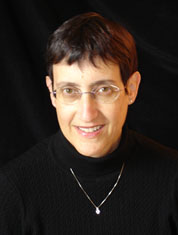 Since then, Paul has carved out an illustrious career in choral conducting and, this month, will return to the Pomona campus as clinician of the 2012
Since then, Paul has carved out an illustrious career in choral conducting and, this month, will return to the Pomona campus as clinician of the 2012 